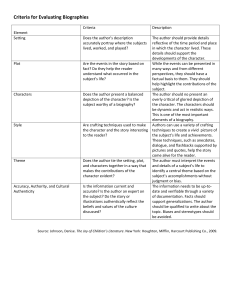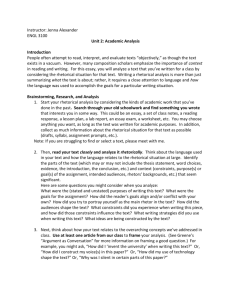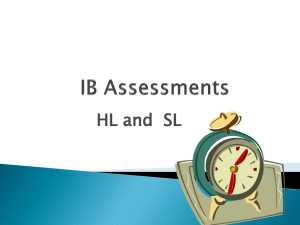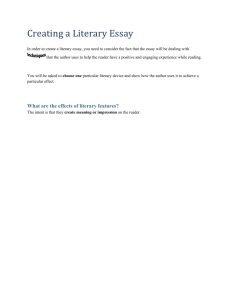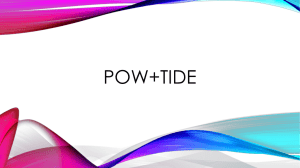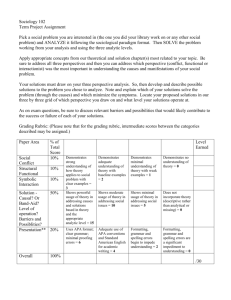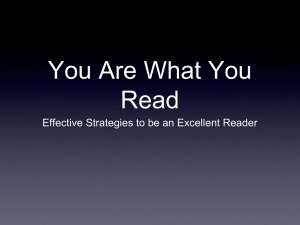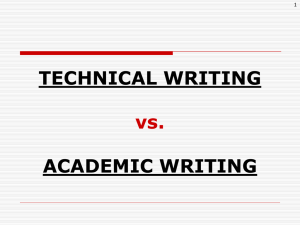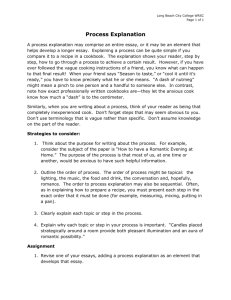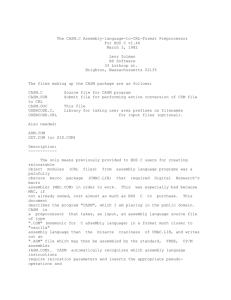Fall2015 Unit II Writing Assignment
advertisement
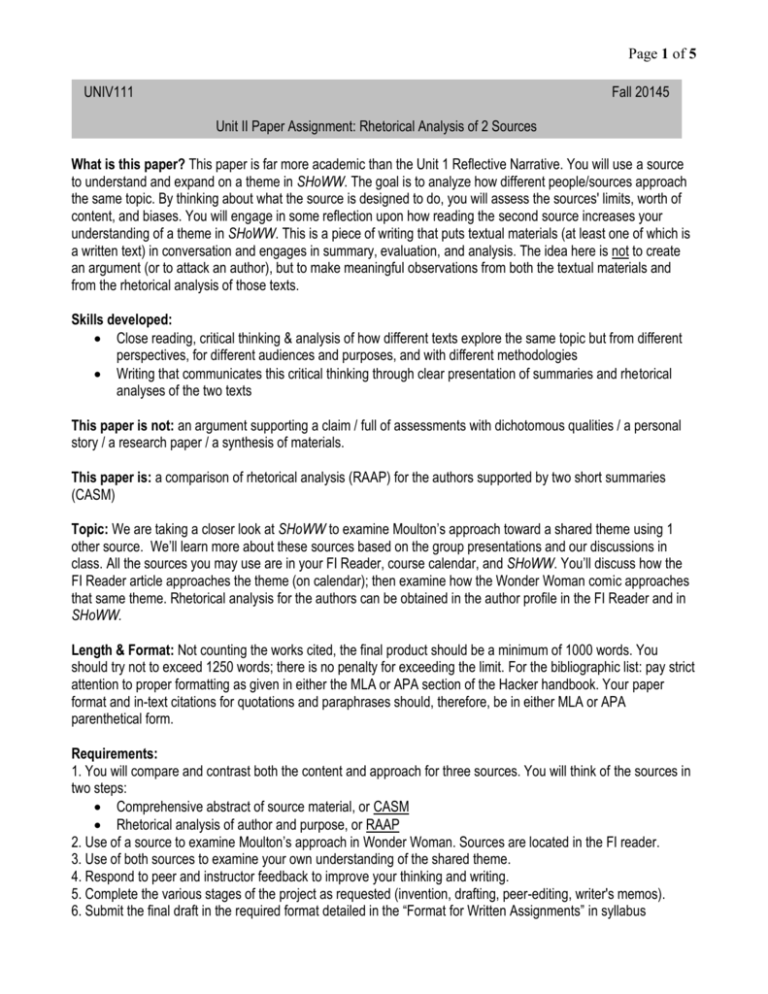
Page 1 of 5 UNIV111 Fall 20145 Unit II Paper Assignment: Rhetorical Analysis of 2 Sources What is this paper? This paper is far more academic than the Unit 1 Reflective Narrative. You will use a source to understand and expand on a theme in SHoWW. The goal is to analyze how different people/sources approach the same topic. By thinking about what the source is designed to do, you will assess the sources' limits, worth of content, and biases. You will engage in some reflection upon how reading the second source increases your understanding of a theme in SHoWW. This is a piece of writing that puts textual materials (at least one of which is a written text) in conversation and engages in summary, evaluation, and analysis. The idea here is not to create an argument (or to attack an author), but to make meaningful observations from both the textual materials and from the rhetorical analysis of those texts. Skills developed: Close reading, critical thinking & analysis of how different texts explore the same topic but from different perspectives, for different audiences and purposes, and with different methodologies Writing that communicates this critical thinking through clear presentation of summaries and rhetorical analyses of the two texts This paper is not: an argument supporting a claim / full of assessments with dichotomous qualities / a personal story / a research paper / a synthesis of materials. This paper is: a comparison of rhetorical analysis (RAAP) for the authors supported by two short summaries (CASM) Topic: We are taking a closer look at SHoWW to examine Moulton’s approach toward a shared theme using 1 other source. We’ll learn more about these sources based on the group presentations and our discussions in class. All the sources you may use are in your FI Reader, course calendar, and SHoWW. You’ll discuss how the FI Reader article approaches the theme (on calendar); then examine how the Wonder Woman comic approaches that same theme. Rhetorical analysis for the authors can be obtained in the author profile in the FI Reader and in SHoWW. Length & Format: Not counting the works cited, the final product should be a minimum of 1000 words. You should try not to exceed 1250 words; there is no penalty for exceeding the limit. For the bibliographic list: pay strict attention to proper formatting as given in either the MLA or APA section of the Hacker handbook. Your paper format and in-text citations for quotations and paraphrases should, therefore, be in either MLA or APA parenthetical form. Requirements: 1. You will compare and contrast both the content and approach for three sources. You will think of the sources in two steps: Comprehensive abstract of source material, or CASM Rhetorical analysis of author and purpose, or RAAP 2. Use of a source to examine Moulton’s approach in Wonder Woman. Sources are located in the FI reader. 3. Use of both sources to examine your own understanding of the shared theme. 4. Respond to peer and instructor feedback to improve your thinking and writing. 5. Complete the various stages of the project as requested (invention, drafting, peer-editing, writer's memos). 6. Submit the final draft in the required format detailed in the “Format for Written Assignments” in syllabus Page 2 of 5 Stages of the assignment: (dates for completing are listed in the course calendar): 1. Complete an invention process during the class workshop. 2. Complete a first draft and submit it to the Discussion in Blackboard for peer review by your writing group. 3. Complete a writer’s memo for your first draft and submit it to the correct Blackboard Journal. 4. Peer review your group members’ drafts and respond to peer review. 5. Revise the draft and submit it to the Blackboard submit assignments tab with your writer’s memo. Optional Structure for this Essay: • Introduction of the two sources (Article + WW Comic) and your thesis summarizing your comparison of their approaches • Discussion of the audiences and purposes of the two texts (Article of your choice and WW comic) • CASM of the relevant parts of article in the FI Reader • Rhetorical analysis of article's approach to the shared theme. • CASM of the relevant parts of WW Comic (visual literacy is key!) • Rhetorical analysis of Moulton's approach to the shared theme + Comparison of the 2 texts’ approach to the topic which should include reference to audience and purpose. • Discussion of how the sources and SHoWW influenced your understanding and familiarity of the shared theme. First Draft: Your first draft should be typed and formatted according to MLA or APA guidelines. It should be close to the page requirements (at least 2/3s the length of your final draft). It should be proofread and spell-checked to make your peer reviewers work easier. Instructions for submitting your first draft to Bb for peer review: Make sure you have a compatible word processing program. Microsoft Word is the required format. Name your first draft file with a descriptive file name so you can find it easily and others can recognize it as yours (something like “SmithJ Unit 1 1st draft”). Do not forget to include the first draft writer’s memo as the first page of your document. Submit an electronic file copy of your first draft to the discussion board: have your file available on the computer hard drive and/or a connected external drive. On Bb, click Discussions > U2 – First Draft > Create Thread > [title or your name as subject] > [follow instructions under “forum descriptions”]. Writer’s memo: 1st Draft: Include this as an entry in the correct Bb journal. You may list your responses to the following in well-developed, thoughtful, complete sentences. You should provide multiple and specific details in answering. 1. How much out-of-class-time have you spent on the writing process up to this point? 2. What “global” aspect(s) of your first draft do you want reviewers to pay attention to and provide feedback on? Why? Explain with some detail. (Remember not to focus on sentence-level issues like grammar, mechanics, and spelling right now.) 3. What “global” aspect(s) of the draft are you most confident about? Why? Explain with some detail. (Aspects of the project include, but are not limited to: understanding the purpose of the essay; understanding &/or speaking to the desired reading audience; incorporating one of the readings; thinking critically & developing your ideas sufficiently; organizing your essay in an effective way, etc.) 4. Compare the effort on your draft to the writing rubric. If you were asked to turn this draft in as the final paper, what grade would you expect, and why? 5. What is your plan for finishing until you have a product you are proud of? What else do you have to do? How many hours do you have left? Page 3 of 5 Final Draft: Your final draft should be formatted according MLA or APA guidelines. It should include a Works Cited or References page (last page) and a self-evaluation (first page) as part of the file. Name your final draft file something different so you don’t mix it up with an earlier version (e.g. SmithJ final unit 1). On the first page of the file, you will copy and paste the rubric below. Then, you will “grade” your efforts based on the criteria on the rubric. Be honest; you may find that you have completed some “A” work in some areas and “B” work in others. For each of the skills you highlight, write a couple sentences explaining why you evaluated yourself that way. For the 9 skills on the rubric, there will be a minimum of 18 sentences. Final papers will not be accepted without both the rubric and the reflective paragraph. Purpose (Analysis) Writing Thinking Insufficient Emerging Skill Competent No demonstrated writing objectives; may be deliberately off topic Does not identify appropriate problem/question or fails to use evidence to address it Little demonstration of writing objectives Demonstrates writing objectives Appropriate problem/question not clearly identified and/or weak or inappropriate evidence is used to address it May demonstrate problems in structuring writing; paragraphs exist but are poorly structured or illogically ordered; transitions between different ideas may not exist or may be ineffective Significant confusion in sequence of evidence and ideas Organization of Ideas Writing A complete lack of structure; paragraphs are nonexistent or incoherent; no evidence of logical transitions between ideas Thinking Presents evidence and ideas in highly confused or confusing sequence; shows Emerging Expertise Clearly demonstrates writing objectives Expert Appropriate problem/question identified and evidence is used to address it Consistently identifies appropriate problem/question and evidence is used to address it Gives novel perspective on appropriate problem/question and/or uses original evidence to address it Is organized around a central theme or idea; paragraphs are adequately structured and ordered throughout the paper; shows some transitions between different ideas Paragraph order and structure add to the clarity of a central theme or idea; clear, effective transitions between all ideas Sequence of evidence and ideas generally clear, but may be somewhat flawed Sequence of presentation reflects clear relationship or organization of Paragraph order and structure provide clear, focused, unified, and coherent structural support of a central theme or idea throughout the paper; has particularly strong transitions between ideas; may show creativity or innovation in structuring writing Sequence of presentation reflects exceptionally clear relationship or Demonstrates appropriate writing objectives in an innovative way Page 4 of 5 Development of Ideas Writing Thinking Audience (Relativism) Writing no ability to build a unique argument from pieces of information and evidence; relies on the form and logic of arguments made in source information Completely Ideas superficial; undeveloped; attempts to ideas superficial explain assertions and unsupported; ideas Sometimes supports assertions with appropriate examples or evidence; Consistently well developed, with appropriate examples and evidence to support assertions organization of ideas, subordinating appropriately for importance and impact Fully developed; provides detailed support for assertions as well as clear connections between individual ideas and the paper’s overarching goal or claim Fails to distinguish May make Use of evidence Specific assertions Demonstrates between cause generalizations distinguishes and their evidence understanding of and coincidence; without support or cause from work toward the how facts shape shows no ability to provides support coincidence, essay’s main goal but may not build a unique that is though or claim; confirm opinion; argument from inappropriate for presentation may demonstrates recognizes bias, pieces of the be flawed; sophisticated including selection information and problem/question demonstrates methods of bias, and chooses evidence success in recombining sources in a understanding evidence into new balanced way; how evidence may and creative ways clearly be used in ways to make a logical distinguishes different from and effective coincidence from original sources; argument though causal attempts to inconsistencies relationships; recombine remain shows evidence in a new sophisticated skills way to support of logic and arguments creativity in recombining points of evidence in new and creative ways to make a logical and effective argument Lack of awareness Limited awareness Adequate Consistent Sophisticated of reader of reader awareness of awareness of awareness of expectations; expectations; reader reader reader Page 5 of 5 writing is inappropriate for the intended reader Thinking Grammar/ Mechanics Demonstrates egocentric approach to issues and a lack of awareness of own biases Frequent grammar or mechanical errors significantly disrupt the meaning of the text writing is sometimes inappropriate for the intended reader Seems aware of biases at only a rudimentary level expectations; writing is adequate for intended readers expectations; writing attends to the intended readers expectations; crafts writing to speak to the intended readers Shows an acceptable level of analysis using verification and skepticism toward authority Analyzes issues and biases with a sense of scope and context sensitive to reader May show patterns of flaw in grammar, mechanics, and word choice that sometimes interferes with meaning or comprehension Demonstrates competent writing; may have some grammatical or mechanical flaws; flaws don’t interfere with comprehension or the writing Evidences control of grammar, word choice, and mechanics; may have a few minor flaws Analyzes issues with clarity and sense of scope and context; fully acknowledges bias but provides clear arguments to support the position with an understanding of alternative perspectives Evidences superior control of grammar, word choice, and mechanics To turn your essay in: Go to the Submit Assignments tab on Blackboard and look for the “Unit II Essay” submission link. Read the instructions there. Click the correct “Browse” button to find your file, and select the final draft file; then hit “Submit.” DO NOT paste your paper into the box—with your final draft, always attach the file.
